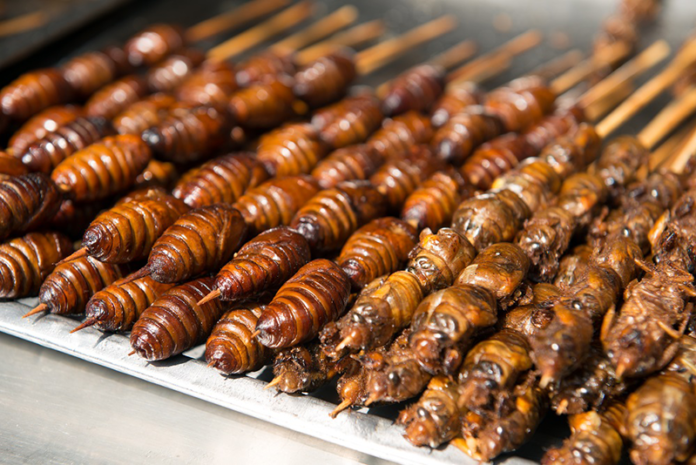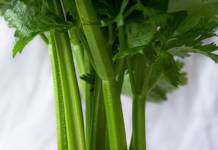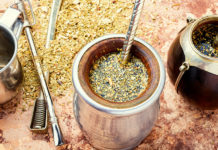Remember the old lady who swallowed a fly? Perhaps she owed her longevity, in part, to eating insects. (She should have stopped there, of course, rather than eating all of the subsequent animals.) But eating flies–or other insects–could be commonplace in western society before long.
Perhaps you’ve heard the buzz that eating insects is the next big trend, already the norm in many countries, though currently a hipster fad in this one–at least for now. Events from Los Angeles to Philadelphia are hosting insect dinners, even pairing invertebrates with alcoholic drinks. A horrified Tara Nurin, a contributor to Forbes, wrote about the trend in 2017, chagrined that “sane, civilized, non-starving people… are pairing creepy crawlies with beer, wine, and spirits with gusto.”
I have occasionally had patients ask me, “Is eating bugs really a thing?” And I expect I’ll get more and more questions about it, since insects-as-food are taking off in earnest. As a doctor, of course my main curiosity rests on their nutritional value. Let’s take a look at who and why people are eating bugs and whether they offer a healthful option for your diet.
What’s in a Bug?
Insects or insect larva are, put simply, meat. They provide protein that is low in fat and carbohydrates. They also offer a rich source of amino acids and other vitamins and minerals such as iron and calcium. What’s not to love?
Researchers at the Czech University of Life Sciences Prague analyzed the nutritional content of a variety of edible insects. NFS Journal published their findings in 2016.
- Protein content ranges from 20 to 76% of dry matter depending on the type and development stage of the insect.
- Fat content ranges from 2 to 50% of dry matter. Polyunsaturated fatty acids content may account for as much as 70% of that.
- Minerals including potassium, sodium, calcium, iron, zinc, copper, manganese and phosphorus may be found in what the researchers termed “reasonable amounts.”
- Depending on the type of insect, they may include B vitamins, as well as vitamins A, D, E, K, and C.
That all sounds great, but you might wonder how it stacks up against more traditional forms of meat. A 2016 study published in the European Journal of Clinical Nutrition compared beef, pork, and chicken against six commercially available insect species. The researchers assigned a nutritional score to each subject. While they emphasized that results varied widely from one insect species to another, they stated that “crickets, palm weevil larvae, and mealworm [have] a significantly healthier score than beef and chicken.” They added, “No insects were statistically less healthy than meat.”
If the nutritional results remain uncompelling, many advocates emphasize the capacity of insects to feed a burgeoning world population with lower greenhouse gas emissions and less water consumption.
Is Eating Insects Safe?
A 2018 study from Rutgers University confirmed that almost all primates, including humans, can eat and digest the exoskeletons of insects, contrary to earlier belief. (In case you’re curious, it’s the CHIA gene that’s responsible for producing the enzyme capable of breaking down the material.) The researchers concluded that insects were an extremely important food source for our early ancestors, especially in the absence of vertebrate animals.
The Czech University study I mentioned above cautions that some insects may produce or contain toxic bioactive compounds. As well as residual pesticides and heavy metals from the environment. As with any food, experts advise that you wash and prepare insects using hygienic practices, and ideally, cook them. Note that insect exoskeletons are made of chitin, similar to that of shellfish. In other words, people with shellfish allergies should proceed with caution.
So… What Do They Taste Like?
There are hundreds of varieties to choose from, so of course they all taste different. Many people describe insects, in general, as “nutty” in flavor. Some people describe larvae as having an earthy or mushroom-like flavor.
Spiders, anyone? Daniella Martin, an “Edible Insect Advocate,” adds “arachnids often taste like a light, earthy version of shellfish, crab, and lobster in particular.” Insect chefs typically add salt or spices, so the cuisine tends to take on the flavor of the seasoning.
For aspiring entomophogists (insect-eaters), the website Eat Bugs Events lists everything from bug cooking classes to private dinners. The site proudly declares, “Bugs are easier on the environment than traditional protein sources, packed with nutrition, and can taste great. They are not the only solution to sustainably feed our growing population, but they are the most provocative.”
If you have been eating edible insects, or you start exploring them, let us know what you think! As this trend becomes more popular, health care professionals like myself will be watching closely.








